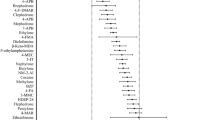Abstract
Involvement of D1 and D2 dopamine receptors in the effects of cocaine on schedule-controlled behavior was evaluated in squirrel monkeys responding under a multiple fixed-interval 5-min, fixed-ratio 10 schedule (mult FI FR) of food delivery. Cocaine and the D2 agonist quinpirole increased responding under the FI at certain doses and disrupted the temporal patterning of behavior. Higher doses of these drugs decreased responding. In contrast, the D1 agonist SKF 38393 was devoid of behavioral activity up to 10 mg/kg where response suppression was obtained without significant modification of the temporal distribution of responding. The D2 antagonist haloperidol (0.001–0.03 mg/kg) did not alter the behavioral effects of cocaine up to doses that had pronounced behavioral effects on their own. However, haloperidol attenuated the behavioral effects of quinpirole. In contrast, the D1 antagonist SCH 23390 partially attenuated the response rate-suppressant effects of cocaine without blocking cocaine-induced disruptions of temporal response patterning. SCH 23390 did not antagonize the behavioral effects of SKF 38393. These results suggest that independent stimulation of either D1 or D2 receptors alone does not play a major role in the effects of cocaine on schedule-controlled behavior of squirrel monkeys.
Similar content being viewed by others
References
Barrett RL, Appel JB (1989) Effects of stimulation and blockade of dopamine receptor subtypes on the discriminative stimulus properties of cocaine. Psychopharmacology 99:13–16
Bergman J, Spealman RD (1988) Behavioral effects of histamine H1 antagonists: Comparison with other drugs and modification by haloperidol. J Pharmacol Exp Ther 245:471–478
Bergman J, Madras BK, Johnson SE, Spealman RD (1989) Effects of cocaine and related drugs in nonhuman primates. III. Self-administration by squirrel monkeys. J Pharmacol Exp Ther 251:150–155
Clark D, White FJ (1987) Review: D1 Dopamine receptor — the search for a function: a critical evaluation of the D1/D2 dopamine receptor classification and its functional implications. Synapse 1:347–388
Colpaert FC, Niemegeers CJE, Janssen PAJ (1978) Discriminative stimulus properties of cocaine andd-amphetamine, and antagonism by haloperidol: a comparative study. Neuropharmacology 17:937–942
Gollub LR (1964) The relations among measures of performance on fixed-interval schedules. J Exp Anal Behav 7:337–343
Hake DF, Azrin N (1963) An apparatus for delivering pain shock to monkeys. J Exp Anal Behav 6:297–298
Heikkila RE, Orlansky H, Cohen G (1975) Studies on the distinction between uptake inhibition and release of dopamine in rat brain tissue slices. Biochem Pharmacol 24:847–852
Hyttel J (1983) SCH 23390: the first selective dopamine D1 antagonist. Eur J Pharmacol 91:153–154
Iorio LC, Barnett A, Leitz FH, Houser VP, Korduba CA (1983) SCH 23390, a potential benzazepine antipsychotic with unique interactions on dopaminergic systems. J Pharmacol Exp Ther 226:462–467
Johanson C-E, Fischman MM (1989) The pharmacology of cocaine related to its abuse. Pharmacol Rev 41:3–52
Katz JL, Witkin JM (1991) Behavioral effects of cocaine alone and in combination with selective dopamine antagonists in the squirrel monkey. Psychopharmacology 103:33–40
Kebabian JW, Calne DB (1979) Multiple receptors for dopamine. Nature 277:93–96
Kleven MS, Anthony EW, Goldberg LI, Woolverton WL (1988) Blockade of the discriminative stimulus effects of cocaine in rhesus monkeys with the D1 dopamine antagonist SCH 23390. Psychopharmacology 95:427–428
O'Boyle KM, Gaitanopoulos DE, Brenner M, Waddington JL (1989) Agonist and antagonist properties of benzazepine and thienopyridine derivatives at the D1 dopamine receptor. Neuropharmacology 28:401–405
Ritz MC, Lamb RJ, Goldberg SR, Kuhar MJ (1987) Cocaine receptors on dopamine transporters are related to self-administration of cocaine. Science 237:1219–1223
Schindler CW, Tella SR, Witkin JM, Goldberg SR (1991) Effects of cocaine alone and in combination with haloperidol and SCH 23390 on cardiovascular function in squirrel monkeys. Life Sci 48:1547–1554
Setler PE, Sarau HM, Zirkle CL, Saunders HL (1978) The central effects of a novel dopamine agonist. Eur J Pharmacol 50:419–430
Spealman RD (1990) Antagonism of behavioral effects of cocaine by selective dopamine receptor blockers. Psychopharmacology 101:142–145
Spealman RD, Goldberg SR, Kelleher RT, Goldberg DM, Charlton JP (1977) Some effects of cocaine and two cocaine analogs on schedule-controlled behavior of squirrel monkeys. J Pharmacol Exp Ther 202:500–509
Spealman RD, Madras BK, Bergman J (1989) Effects of cocaine and related drugs in nonhuman primates. III. Stimulant effects on schedule-controlled behavior. J Pharmacol Exp Ther 251:142–149
Titus RD, Kornfeld EC, Jones ND, Clemens JA, Smalstig EB, Fuller RW, Hahn RA, Hynes MD, Mason NR, Wong DT, Foreman MM (1983) Resolution and absolute configuration of an ergoline-related dopamine agonist, trans-4,4a,5,6,7,8,8a,9-octahydro-5-propyl-1H(or 2H)-pyrazolo[3,4-g]quinoline. J Med Chem 26:1112
Waddington JL, O'Boyle KM (1989) Drugs acting on brain dopamine receptors: a conceptual re-evaluation five years after the first selective D-1 antagonist. Pharmacol Ther 43:1–52
Witkin JM, Goldberg SR, Katz JL (1989) Lethal effects of cocaine are reduced by the dopamine-1 receptor antagonist SCH 23390 but not by haloperidol. Life Sci 44:1285–1291
Witkin JM, Nichols DE, Terry P, Katz JL (1991) Behavioral effects of selective dopaminergic compounds in rats discriminating cocaine injections. J Pharmacol Exp Ther (in press)
Woods JH, Winger GD, France CP (1987) Reinforcing and discriminative stimulus effects of cocaine: analysis of pharmacological mechanisms. In: Fisher S, Raskin A, Uhlenhuth EH (eds) Cocaine: clinical and biobehavioral aspects. Oxford University Press, New York, pp 21–65
Woolverton WL, Kleven MS (1988) Multiple dopamine receptors and the behavioral effects of cocaine. In: Clouet D, Asghar K, Brown R (eds) Mechanisms of cocaine abuse and toxicity. NIDA Research Monograph 88. US Gov't Printing Office, Washington (DHHS publication number (ADM)88-1588), pp 160–184
Author information
Authors and Affiliations
Rights and permissions
About this article
Cite this article
Witkin, J.M., Schindler, C.W., Tella, S.R. et al. Interaction of haloperidol and SCH 23390 with cocaine and dopamine receptor subtype-selective agonists on schedule-controlled behavior of squirrel monkeys. Psychopharmacology 104, 425–431 (1991). https://doi.org/10.1007/BF02245644
Received:
Revised:
Issue Date:
DOI: https://doi.org/10.1007/BF02245644




